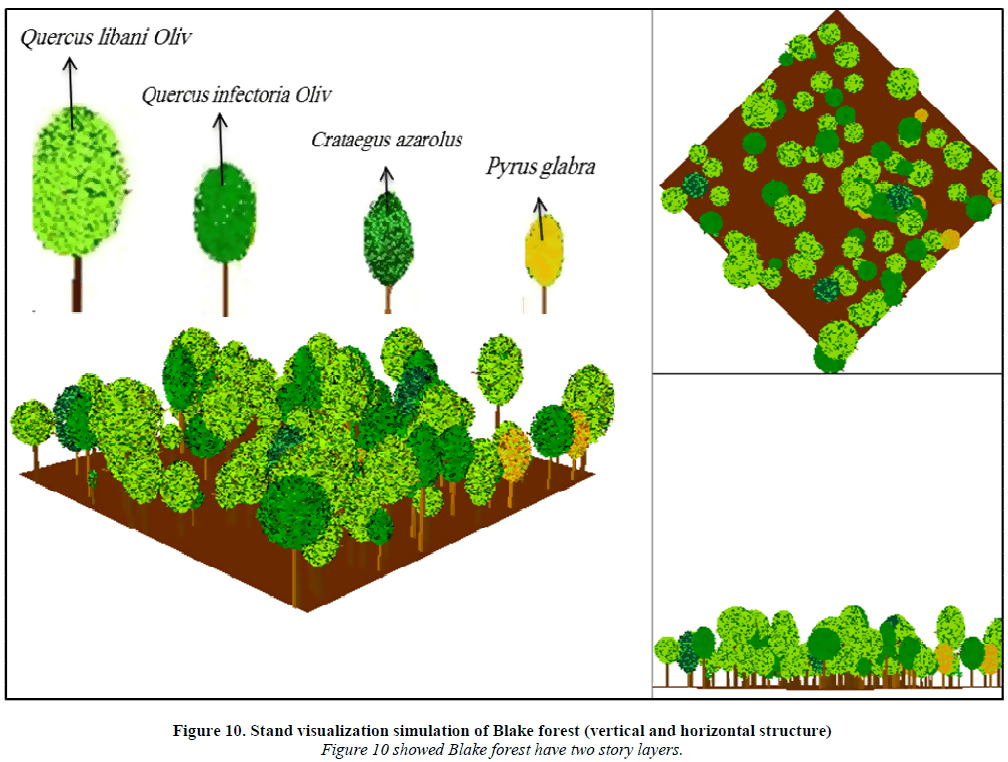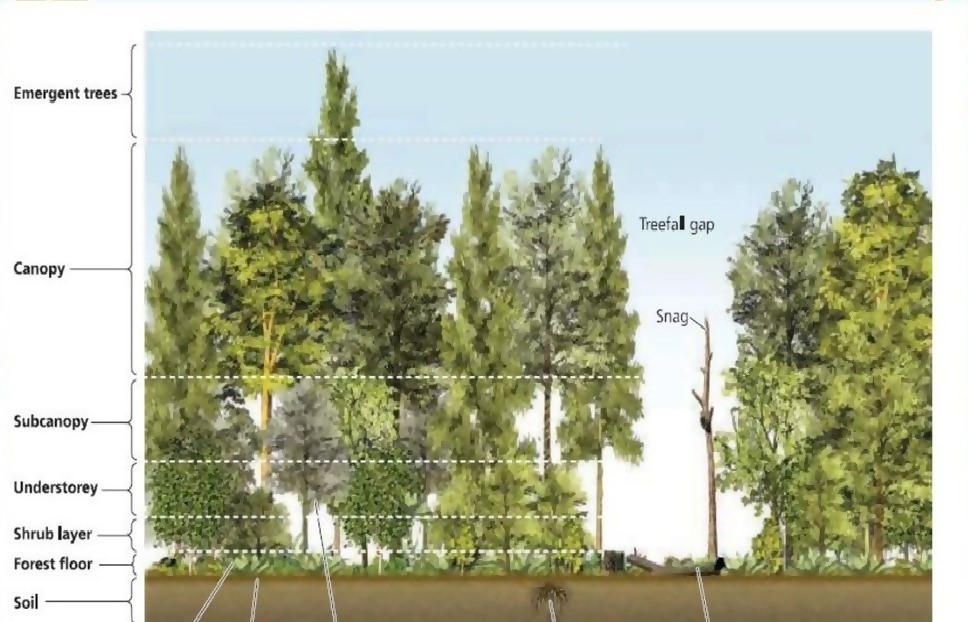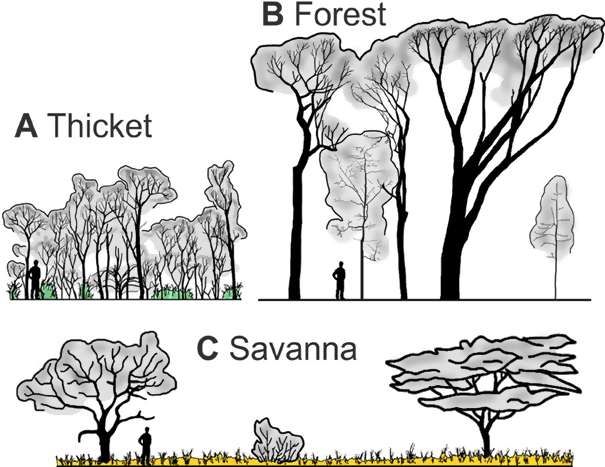The Tops of Tall Trees in a Rainforest Form a Continuous Layer of Leaves Referred to as a
The Forest Canopy: Structure, Roles & Measurement

October 14, 2020 at 12:58 am | Updated October 14, 2020 at 12:58 am | 6 min read
The Importance of Forest Canopy Structure
If you are looking for a classic example of the circle of life, consider the forest canopy structure. A forest's canopy structure is influenced by environmental and soil factors, and it also influences these factors in return. It is an aspect of forest ecology that is receiving more attention in this age of climate change emergency. The canopy structure is often overlooked, with most of the focus being on biodiversity. One of the reasons could be that the forest canopy structure is a more complex concept, which cannot be easily captured in a number.
Understanding Forest Canopy Structure
A forest or any biome is made up of several trees that belong to many species. A tree has a stem and a crown of branches that bear leaves, flowers, and fruits. Though forest canopy structure can mean different things, it basically refers to the arrangement of tree crowns; it has two components: the vertical structure and horizontal structure.

Figure1: The figure at the top right shows the horizontal structure, while the bottom right shows the vertical structure. The figure on the left shows the different species making up the forest. (Image credits:http://www.imedpub.com/articles/study-of-vertical-and-horizontal-forest-structure-in-northern-zagros- forest-case-study-west-of-iran-oak-forest.php?aid=11590)
- Horizontal structure is created by the placement of trees and how close their crowns are to each other. A collection of these crowns creates the canopy (See Figure 1).
- Vertical structure is formed because trees and shrubs in a forest will have different heights. So, two or more layers of tree crowns can be found in forests. These layers are called forest storeys or strata. The top-most stratum is made of emergent trees; below them are the canopy trees, which are usually present as a continuous layer. The tree strata below them are called the sub-canopy and the understorey. Next, close to the ground could be shrubs, herbs, and grasses (See Figure 2).
Complicating this concept of forest structure is the issue of spatial scale, i.e., space or area that is considered for estimating the canopy structure.
Regional Scale
At a regional scale, the number of trees, shrubs, herbs, their species, and their arrangements give the forest canopy structure (See Figure 3). At this large scale, forest canopy structure defines the biome and its conditions, and it tells us whether the forest is
- Continuous/patchy or pristine/disturbed.
- Coniferous, scrub, savanna, grassland, broadleaved, etc.
Remote sensing is the preferred method of collecting data about forest canopy structure at large scales.
Local Scale
At the local scale, forest stand attributes, such as tree girth, the shape of a crown, height, and tree architecture, are the defining characteristics of forest canopy structure. Here, the forest canopy structure can also refer to the total quantity of leaves in a forest. Ground based methods are used to collect data on local forest canopy structure.

Figure 2: Vertical Forest Structure. (Image credits:https://slideplayer.com/slide/13767425/ )
Role of Forest Canopy Structure
Forest canopy structure determines many of the environmental factors and functions of a forest and is, therefore, important for all the species living in a forest.
- Light interception: Light distribution within the forest depends on the number of layers. The upper layers will get more light radiation, with little light coming through to the forest floor, if the canopy is dense. For this reason, there is little grass and herbs in well-developed and old forests. The amount of light reaching lower parts of a tree is also important as photosynthesis depends on it. So, there is more photosynthesis in the upper layers of a forest canopy.
- Moderate temperature: Temperatures within a forest vary with height. At the upper canopy layers, temperatures are extreme and fluctuate more, while in the forest interior, they are moderate and stable, making forest floors preferred homes of large animals like ungulates.
- Wind and rain protection: Forest canopies act as a windbreak and intercept rainfall making the forest interior more hospitable.
- Produces niches: The combination of environmental conditions at various heights creates a myriad of microclimates, which provide specialised niches for other plants, animals, birds, insects, etc. For example, epiphytes grow in branch nooks, and most insects live in the crowns of trees.
- Structural diversity: Besides the microclimates, the forest canopy with its branches and arboreal connections creates structural diversity which is vital for the survival of many animals. For example, many tree-dwellers escape ground predators by staying and moving in the canopy.
- Biodiversity: As a result of its influences, the forest canopy structure is necessary to maintain the biodiversity of a forest. Differing forest canopy structures of biomes increase the overall biodiversity of the earth.

Figure 3: Biome vegetation structure. A Thicket with a low closed canopy and a discontinuous layer of shade tolerant grasses; B Forest with a tall closed canopy, no grass layer, and a mid-storey of shade-tolerant trees; C Savanna with a continuous C4 grasses layer and a discontinuous tree cover. From Charles-Dominique, et.al. (2015) (Image credita DOI: 10.1016/j.sajb.2015.05.005.
Uses of Canopy Structure
Besides the importance of forest canopy structure for the forest ecosystem, it is useful for people in many ways and is therefore monitored. Some of the most important uses are as follows:
- Ecosystem Productivity: Forest canopy structure studies at the regional and local scales have often been used to determine carbon uptake, storage, and flux for carbon accounting and validation. Such productivity analysis is common in climate change mitigation studies.
- Ecosystem Services: It is the canopy structure of the forest that determines many of the ecosystem services we associate with forests. These could be:
- Intercepting and helping in percolation of 60-90% of rainwater/ snow gently into the soil and producing a watershed region important for the hydrology of a region.
- Providing people and animals with clean drinking water.
- Producing litter (leaves, fallen branches, etc.) that maintain soil fertility and soil carbon banks.
- Providing a canopy or ground cover that protects soil from the force of rain and a mat of roots that hold soil to conserve it.
- Forest canopies hold a lot of the water that trees absorb and recirculate it into the atmosphere through transpiration, providing input for rain, so the water cycle is maintained. For example, one-third of the rainfall in the Amazons is due to the forest canopy.
- Agricultural productivity: Many cash crops have been traditionally cultivated as understorey crops and require a forest canopy to thrive. Examples are cardamom, coffee, or cacao.
- Forestry: Forest canopy structure is also regulated because many commercial forests provide timber and wood.
- Non-timber products: It is essential to maintain and monitor primary forests' canopy, as it provides non-timber products such as medicinal plants, nuts, fruits, resins, barks, etc. The tree crown provides most of these products.
- Ecology studies: Forest canopies are a reflection of available moisture and soil types, and differences in canopy structure can establish gradients in site quality of forests.
Measuring Forest Canopy Structure
Forest canopy structure can be measured on the ground by quantifying the leaf area in the forest or through forest cover estimation. The Plant Canopy Imager CI-110, produced by CID Bio-Science captures wide-angle canopy images while estimating Leaf Area Index (LAI) and measuring Photosynthetically Active Radiation (PAR) levels. It has a GPS to provide the exact coordinates of a place, for repeat observations. The GPS makes it also possible to integrate ground observations with remote sensing data in Geographical Information System (GIS) to expand its efficiency.
—
—
Vijayalaxmi Kinhal
Science Writer, CID Bio-Science
Ph.D. Ecology and Environmental Science, B.Sc Agriculture
Source
Bongers, F. (2001). Methods to assess tropical rain forest canopy structure: an overview.
Plant Ecology, 153-263. https://doi.org/10.1023/A:1017555605618
British Columbia Ministry of Forests. Module 3 — Stand level components of biodiversity. Retrieved from https://www.for.gov.bc.ca/hfp/training/00001/module03/standstructure2.htm
Charles-Dominique, T., Carla Staver, A. C., Midgley, G. F., & Bond, W.J. (2015). Functional differentiation of biomes in an African savanna/forest mosaic. South African Journal of Botany. DOI: 10.1016/j.sajb.2015.05.005.
Ellsworth, D.S., & Reich, P.B. (1993). Canopy structure and vertical patterns of photosynthesis
and related leaf traits in a deciduous forest.Oecologia 96,169-178. Retrieved from https://www.uv.mx/personal/tcarmona/files/2010/08/Ellsworth-y-Reich-1993.pdf
Forest Structure. Retrieved from https://extension.unh.edu/goodforestry/m/2-2.htm
Forests and non-timber forest products. Retrieved from https://www.cifor.org/Publications/Corporate/FactSheet/ntfp.htm
Haidari, M., Namiranian, M., Gahramani, L., Zobeiri, M., & and Shabanian, N. Study of vertical and horizontal forest structure in Northern Zagros Forest (Case study: West of Iran, Oak forest).Retrieved from http://www.imedpub.com/articles/study-of-vertical-And-horizontal -forest-structure-in-northern-zagros-forest-case-study-west-of-iran-oak-forest.php?aid=11590
Retrieved from https://www.sciencedirect.com/topics/agricultural-and-biological-sciences/forest-canopy
Robert Fahey. (2017, February 1). Forest Canopy Structure: What Does That Mean and Why Does It Matter? Retrieved from https://stormwise.uconn.edu/2017/02/01/forest-canopy-structure
-what-does-that-mean-and-why-does-it-matter/#
Smith, M.L., Anderson, J., Fladeland, M. (2008) Forest Canopy Structural Properties. In: Hoover C.M. (eds) Field Measurements for Forest Carbon Monitoring. Springer, Dordrecht. https://doi.org/10.1007/978-1-4020-8506-2_14
Request a quote for a CID Bio-Science product
Pricing and all related materials will be sent directly to your inbox.
Source: https://cid-inc.com/blog/the-forest-canopy-structure-roles-measurement/
Belum ada Komentar untuk "The Tops of Tall Trees in a Rainforest Form a Continuous Layer of Leaves Referred to as a"
Posting Komentar